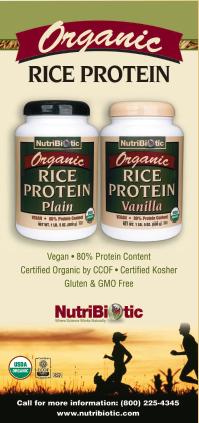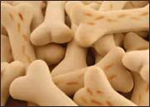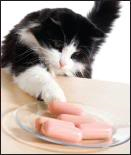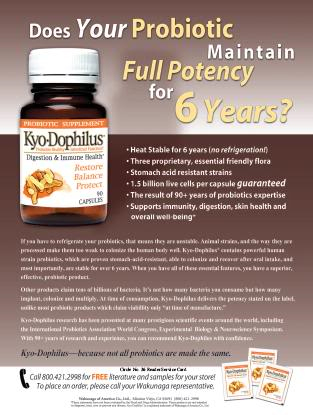 In 2008, one of the most popular consumer magazines for dog owners began offering an annual supplement called Natural Dog, with information about natural products and holistic pet care. A major pet store chain billed it as a way to help owners “upgrade” their animal care. Think about this language. It implies that traditional pet products are “just okay” while owners that want the best of the best should turn to natural and organic foods, treats, litter and supplements.
In 2008, one of the most popular consumer magazines for dog owners began offering an annual supplement called Natural Dog, with information about natural products and holistic pet care. A major pet store chain billed it as a way to help owners “upgrade” their animal care. Think about this language. It implies that traditional pet products are “just okay” while owners that want the best of the best should turn to natural and organic foods, treats, litter and supplements.
Many animal lovers are on board with upping the ante for their furry pals. “Consumers are in ‘humanization’ mode for their pets; meaning, what they purchase for themselves, they will purchase for their pets,” says Stephanie Volo, president of Planet Dog, Portland, ME. “Now more than ever, consumers are focused on living a healthy lifestyle and are very watchful and careful about what to put in their and their families’ bodies. This holds true for their four-legged children.”
The motivation to treat animals like important family members is so strong that owners are willing to shell out extra cash to keep Rover healthy. Says Paul Zobel, director of sales and marketing for World’s Best Cat Litter, Muscatine, IA, “Many retailers don’t realize there is a strong consumer demand for pet products. Even in a tough 2009 economy, the pet category grew almost 5% over 2008 sales."
 The bottom line: If you haven’t ventured into the natural pet care arena, now could be the time to get in on this cash cow. By carrying such in-demand items, says Zobel, “retailers will be able to offer more unique options than the store they are competing against across the street.”
The bottom line: If you haven’t ventured into the natural pet care arena, now could be the time to get in on this cash cow. By carrying such in-demand items, says Zobel, “retailers will be able to offer more unique options than the store they are competing against across the street.”
Here, Kitty Kitty Owner: Starting a Pet Section in Your Store
Whether you have four or 32 feet of space with which to work, a pet section can work in your store. But like many aspects of retailing, some creativity and careful planning will go a long way toward success.
First, Susan D. Weiss, president of Ark Naturals Products for Pets, Naples, FL, offers a bit of advice for what not to do. She says that retailers make their own road blocks to pet care success if they don’t promote the category, position it poorly, or worse, integrate merchandise throughout the store “where the consumer is least likely to look for them.” This means popping a pet care supplement in the midst of your human supplements or stocking pet treats in the middle of your grocery section. Stick to a pet-only area, she advises, even if it’s small.
Mark Shuster, vice president of marketing for WellPet (the parent company of the Wellness brand), Tewksbury, MA, reiterates Weiss’s point about properly positioning one’s pet care section, which, when done right, can bring in excellent sales. He states, “We’re seeing retailers becoming more aware of the importance of correctly merchandising their products. That awareness is leading to better point-of-sale displays, planograms and other marketing aids like educational P-O-P provided to retailers directly from the manufacturers.” Such displays may require retailers to think about having both horizontal shelf space and vertical room for hanging products (like eco-friendly leashes).
|
Select Pet Care Offerings
American BioSciences: NK-9 for immune health, DGP for joint health. Blue Dog Bakery: Healthy, low-fat, all-natural dog treats. EcoBlends: Protect 22 insect repellent for warding off 22 different pests with essential oils. FUR+BODY: Natural pet shampoos/conditioners, Green Tripe Pet Food, Tripe Treats. Green Foods Corporation: Barley Dog, Barley Cat, Omega Bites. Nordic Naturals: Liquid Pet Cod Liver Oil and Omega-3 Pet softgels. Pet Care Systems: Swheat Scoop wheat litter. Planet Dog: Eco-friendly toys, organic treats, shampoo and conditioner, hemp collars and leashes, travel gear and accessories. Rainbow Light Nutritional Systems: Whole Dog Daily powder or chewable whole food supplement, Healthy Motion powder and bone-shaped chewables, Omega Glo-Coat 3-6-9 omega oils and Complete Calm. Sun Chlorella USA: Pet Sun Chlorella, with chlorophyll vitamin D, omega-3 and omega-6 fatty acids, amino acids, lecithin, lutein, protein fiber and eleuthero. Vermont Soap: Organic pet shampoo under the Vermont Soap Organics line. WellPet: Premium natural pet food brands including Wellness and Holistic Select. Wysong: A range of healthy dry, canned and raw pet foods, pet supplements, litter, shampoos and other pet care items. |
He adds that his company has a sales and marketing team that walks retailers through the set up of a pet section and, importantly, helps retailers ensure they have a product mix that makes sense.
In addition, manufacturers are making it easier for shops that don’t have a lot of space to afford a pet section. Jenni Himebaugh, a member of the technical staff at Wysong, Midland, MI, explains that her company offers pet food in compact packaging so “finding space is usually not an issue…We also do not force retailers to order large quantities to get started.”
For those who say they probably can’t afford to bring in a new category, consider this fact courtesy of Weiss: natural product stores are often sold pet products at a deeper discount than pet-only stores. So if retailers want to enter the pet care category, she adds, “they have everything to gain and very little to lose.”
So, which products should you start with? Like your human sections, focus on food/treats, supplements, grooming and eco-friendly accessories.
Satisfying a Chow Hound
It’s not hard to make the case for natural pet foods and treats when doing a side-by-side comparison of ingredients labels. Like human food, the product’s quality is all about the ingredients. Says Mathew Wasmuth, product manager at FUR+BODY Ingredients, White Rock, BC, Canada, “It’s obvious to us that fast foods are loaded with preservatives, dyes and artificial ingredients, and when consumed on a regular basis, pose major health risks. It’s no different for our pets.” Wasmuth suggests that some of the fillers in traditional products could be responsible for some health problems in certain breeds.
Bob Terry, Ph.D., technical services advisor for Green Foods Corporation, Oxnard, CA, makes the point that traditional treats may contain sugar-rich carbohydrates or meat byproducts that are laden with unwanted chemicals and toxins. Such treats are “anti-nutritional,” he says.
For comparison’s sake, Margot Kenly, founder of Blue Dog Bakery, Seattle, WA, offers some insight into what her firm’s natural treats are made with: whole ingredients that are similar to those in human food. Says Kenly, “These ingredients you know and trust. They provide high-quality nutrition without animal by-products, additives and preservatives. This cannot be said for traditional products.”
Where’s the beef? Himebaugh stresses an important point worth noting. Many pet care experts believe that a key benefit to natural pet foods isn’t just about being free of additives; they more closely mimic a carnivore’s diet, which is what dogs and cats are by nature. “There is typically more meat, superior fat content and the presence of minor ingredients such as probiotics, enzymes and nutraceuticals that are not present in more traditional feeds,” she says.
In fact, many experts feel meat should be the primary ingredient. “We’re constantly working to educate consumers and advise them to read the label on their pets’ foods,” says Shuster. “They should find a list of recognizable ingredients, with a meat as the first ingredient listed.”
Volo from Planet Dog goes so far as to say, “Rule of thumb: More meat is always better than less meat.” As a quick checklist, she offers up her opinion for what the first five ingredients in pet foods should be:
- The first two should be a good-quality meat source (and not meat by-products).
- The next three ingredients can contain whole grains rather than refined or processed grains. No cornmeal, gluten or rice protein extract.
These first five ingredients are important, Volo says, because they comprise the majority of the food’s weight. Other appropriate components may include probiotics, prebiotics, antioxidants, vitamins/minerals and amino acids. On a snacks front, Terry adds, “Healthful snacks can be made with whole foods such as fruits and berries, fiber and omega-3 fatty acids.”
 But, one industry insider cautions to use this information with care, and to always use products from reputable companies. Since the first five ingredients are about weight, manufacturers can legally change their formulas to lower-quality ingredients of the same weight and not be required to change their ingredient list. She states, “So often, we’ll hear, ‘I used that food for years and now my dog/cat doesn’t like it.’ Chances are the manufacturer switched suppliers but the consumer doesn’t know it.” Therefore, it’s important to use trustworthy manufacturers.
But, one industry insider cautions to use this information with care, and to always use products from reputable companies. Since the first five ingredients are about weight, manufacturers can legally change their formulas to lower-quality ingredients of the same weight and not be required to change their ingredient list. She states, “So often, we’ll hear, ‘I used that food for years and now my dog/cat doesn’t like it.’ Chances are the manufacturer switched suppliers but the consumer doesn’t know it.” Therefore, it’s important to use trustworthy manufacturers.
Making the switch. If pet owners are hesitant to make the switch from their current pet brands to something new, be sure to tell them to do so a little at a time. “Don’t make a lot of changes at one time. See what happens after making a change, then add something else,” Weiss says. Once the vet says it’s okay to change foods, introduce new foods gradually over several weeks. Start with a little of the new food mixed with the old, then move to a 50/50 new–old ratio, then 75/25.
Going this route is especially important, says Shuster, when the new food is tastier than the older food. “Mixing the food will allow the dog or cat to acclimate to the new taste and not ‘gorge’ or over-indulge on the new food because of its great taste,” he says, adding, “Feeding multiple, smaller volume meals also decreases the likelihood of over-consumption and provides for a more consistent, firm stool. This is an especially good option for puppies and senior dogs.”
Himebaugh recommends that if any digestive difficulties arise, “return to a small percentage and try again.”
|
Foods Pets Should Avoid
Reference |
You’ll Be in the Dog House Without Supplements
Just like with human nutrition, most pets (especially active ones) can benefit from taking certain high-quality supplements to fill in nutritional gaps. Says Himebaugh, “Supplements act as nutritional insurance for animals. One could argue that the need for supplements with animals is even greater than with humans, as the number and types of foods provided are often not as varied, fresh or as healthy…whether sick or healthy, an animal should be given properly designed supplements to bolster health.”
Tom O’Leary, canine health advocate at Rainbow Light Nutritional Systems’ Green Dog Naturals, Santa Cruz, CA, agrees: “As a ‘supplement’ to a dog’s daily diet, premium nutritional formulas can enhance the nutritional value of even a premium food, and give vital support to both healthy digestion and a strong immune system.”
When selecting which suppliers to use, Jean Hofve, D.V.M., an advisory board member for Nordic Naturals, Watsonville, CA, recommends that retailers buy from companies that use human-grade ingredients and eco-friendly practices. “Pets are members of the family, and should receive supplements that meet all the quality standards that human supplements are required to meet,” she says.
In addition, O’Leary recommends carrying products from companies that have been audited by the National Animal Supplement Council (NASC). This firm offers third-party quality testing of pet supplements, and members can use the NASC seal on their labels.
As for which supplements to carry, pet experts suggest the following as a good base:
-
Omega-3 fatty acids. Regardless of whether they are store-bought or homemade pet foods, owners should think about giving animals omega-3s, says Hofve. “All pet foods, including raw and homemade, are deficient in omega-3 fatty acids, which are crucial for the health and function of the nervous system, immune system, skin and coat,” she says, adding that the typical pet diet contains too much pro-inflammatory omega-6s and not enough omega-3s. She adds that dogs cannot efficiently convert ALA omega-3 into DHA/EPA, so it’s best to stick with fish-based omega-3s for cats and dogs.
-
Antioxidants. Pets may not get all the antioxidants they need from their foods, which are beneficial for a healthy immune system and for cellular health. Hofve recommends antioxidants such as vitamins C and E, as well as phytochemicals (plant-based compounds) such as beta-carotene, flavonoids, polyphenols, lutein and lycopene.
-
Digestive enzymes. According to William Farber, D.V.M., a scientific advisory board member to Sun Chlorella USA, Torrance, CA, enzymes are lost during the processing and cooking of pet foods. Giving pets digestive enzymes supports healthy digestion, and they “help the body absorb and utilize nutrients from food substances.” He notes that probiotics help replenish good bacteria for proper digestion and food absorption. “They should be an important part of a pet’s diet,” he comments. Hofve agrees, adding, “Some commercial pet foods have probiotics added, and yogurt contains the well-known probiotic, acidophilus, but these are not concentrated enough to fully benefit the pet.” For more on digestive health for pets, see the sidebar “Natural Remedies for Common Gastrointestinal Disorders in Pets.”
- Last are green foods. Farber says such items “help cleanse and replenish the tissues and blood. Chlorophyll-dense products, such as Pet Sun Chlorella, are excellent ways to accomplish this.”
Keeping your jogging buddy moving. Certain pets have extra nutritional requirements, particularly with respect to bone and joint support. Says Weiss, “Part of the issue is about lifestyle. Part genetics. Part aging. It’s very similar to humans. We put a lot of stress on our joints and it shows.” The situation is magnified for certain large and small breeds, which are more prone to bone and joint problems. For example, hip dysplasia, says O’Leary, is a genetic form of osteoarthritis in large dogs that causes an abnormal hip structure.
|
Natural Remedies for Common Gastrointestinal Disorders in Pets
The most common symptomatic disorders of the GI tract in dogs are nausea, vomiting and/or diarrhea. In most cases, a symptom may represent the actual disorder itself (i.e., non-specific diarrhea), may be only a signal of a minor ailment (i.e., eating too much or too quickly so vomiting occurs), or may be a sign of a serious, underlying condition (i.e., hyperthyroidism or cancer), which would require follow-up and diagnosis. If dogs exhibit episodes of nausea, vomiting, and/or diarrhea for a period exceeding 24 hours, it is important to contact a veterinarian and watch for secondary symptoms such as weight loss, coat/skin eruptions, and/or anorexia, as these may be indicators of a hidden condition of the liver or kidney, an autoimmune disease, or an invasive attack of pathogenic bacteria and/or yeast over-colonization. Other signs to watch for are blood in the vomitus or stool, dehydration (dark urine), weight loss of more than 10% of original body weight, lethargy and appetite loss. If dogs exhibit ineffective vomiting, where he is attempting to burp, but can’t, and attempts at vomiting are non-productive (gagging only), these are major symptoms of Gastric Dilatation-Volvulus, (GDV), also known as “bloat” or “gastric torsion.” Bloat is a life-threatening, emergency condition caused by abnormal dilation and twisting of the stomach, which then obstructs the return of venous blood from the abdomen back to the heart. Bloat normally occurs in wide-chested, larger breeds, such as Great Danes, Standard Poodles and Weimaraners. Although bloat usually requires emergency surgery, just as with other gastrointestinal ailments, keeping your dog fit, well nourished, and supplementing with Coenzyme Q10 (CoQ10) and other heart/GI-healthy supplements (i.e., L-Carnitine) on a regular basis will decrease the risks of mortality.A group of common GI disorders in dogs comes under the heading of inflammatory conditions, which include irritable bowel disease (IBD), food allergies, autoimmune disease, anxiety-related conditions (which imitate IBD due to alternating bouts of diarrhea and constipation) and conditions caused by hyperactivity and/or reactions to certain medications. Regardless of the reason, inflammation of the GI tract always interferes with nutrient absorption, digestion and assimilation. The way to correct an inflammatory problem of the gut is to allow it to heal. If properly protected, the GI tract will repair itself, which then allows for proper nutrient absorption and optimal health. Omega-3 fish oils and coconut oils have been shown to modulate the immune system and aid in the repair of damaged GI epithelial tissue. Supplementing with vitamin-U (a compound first isolated from cabbage juice at Stanford University medical School in the early 1950s) will signal the GI tract to produce and secrete natural protective mucin, which will coat and protect the gut so it can heal (see www.Stomacin-U.com). Because commercial dog foods tend to be high in fiber, which can irritate an already inflamed GI tract, the use of raw diets and home-cooked foods are widely acceptable for many dogs since their fiber content can be controlled or reduced. The use of “living foods” is an efficient and highly absorbable source of nutrition, as all the nutrients are alive and functioning and are delivered to the body in their natural complexed state. This allows the nutrients to work in synergy and heal the tract naturally (just as they do in nature). Robert Berger, M.S., M.VSc., Ph.D., holds a doctorate in biochemistry from the University of Tennessee, and a doctorate in biochemical pharmacology from the University of Pennsylvania. He also holds a master of veterinary science and a master of science in physiology. Over the past 10 years, Berger, a trained research scientist, has been active as a radio talk show co-host on various South Florida stations, as well as a guest on many Health-Talk radio shows around the country. |
To help, the answer is very similar to human nutritional bone/joint supplements. Says Farber, “Glucosamine will help prevent the destructive process associated with joint changes as well as be of value in aiding an already diseased arthritic joint.”
O’Leary agrees, adding that when taken with chondroitin and MSM, the regimen is “consistently proven to give long-term support to health of hips and bones, while supporting the health of cartilage in the joints.”
Stephanie Johnson, pet division brand manager at American BioSciences, Blauvelt, NY, adds another angle: “Certain natural products are believed to help maintain bones/joints, but unfortunately not all issues can be prevented. So, many dogs need something more—something that will support a symptom-free life that continues to involve running, jumping and just enjoying.” She recommends her company’s proprietary blend (DGP) “for pets that might not be living the life they want and deserve.” The supplement incorporates feverfew, celery seed, wheatgrass, boswelia, bromelain, papain, corydalis root, cayenne, turmeric, shark cartilage and Native Australian herbs.
Other beneficial joint health nutrients include ginger, turmeric, hyaluronic acid, omega-3s, certain minerals and other nutraceuticals in pet formulas. Remember, supplements should first be approved by a vet, and, says Randy Kidd, D.V.M., holistic veterinarian, herbalist and author, “Like anything else, supplements won’t work unless they are used consistently.”
Tuning up the immune system. Some experts feel that certain puppies and mature dogs may benefit from the immune system support that supplements can provide. Kidd says, “Puppies, with their developing immune systems can use all the help they can get to stay healthy and avoid crippling infections.”
Terry suggests antioxidants, protein and omega-3 fatty acids as good ways to support immune system development. “Reducing free radical damage to immune system cells with antioxidants and providing these immune cells with the structural components including protein and omega-3 fatty acids promotes the development and function of the immune system,” he explains, adding that “whole food antioxidants such as in berries, carotenoid-rich foods and green foods will help promote good immune function early on and throughout life.”
Another beneficial supplement for pet immune health, says Johnson, is AHCC, which “supports natural killer (NK) cell function so their defenses remain strong.” Natural killer cells kill invading bacteria and viruses and are the immune system’s first line of defense. “So, if NK cell function is not strong and a pet, young or old, is battling an illness that requires a strong immune system, certainly supplementation is a must,” she explains.
 Last, Kidd feels proper immune system support should include probiotics since “the gut is a primary site of immune function” and probiotics “have been shown to enhance immune function as well as being an important source for fending off intestine-borne infections.” More on this link is covered in the sidebar, “Natural Remedies for Common Gastrointestinal Disorders in Pets.”
Last, Kidd feels proper immune system support should include probiotics since “the gut is a primary site of immune function” and probiotics “have been shown to enhance immune function as well as being an important source for fending off intestine-borne infections.” More on this link is covered in the sidebar, “Natural Remedies for Common Gastrointestinal Disorders in Pets.”
Healthy outside-in. As previously noted, essential fatty acids (like omega-3) help support healthy skin and fur. Says Hofve, “Improvements in skin and coat are often the first and most visible results of adding healthy fats to dog and cat diets.”
But, many other nutrients also contribute to skin health like high fiber, protein, antioxidants and lecithin, which is “an important nutrient in Pet Sun Chlorella,” says Farber. On the chlorella front, Farber notes that this green food can help cleanse and detoxify, too.
Terry agrees and adds another important benefit of chlorophyll (such as that in wheat and barley grass) for pets: it helps eliminate breath and body odor. “This may be one reason why pets, especially cats and dogs, love to eat grass,” he explains. Terry points out that a study published in 2007 found “grass eating is a normal and common behavior for dogs and not a sign of any problem. Pet owners should consider giving their pets either fresh young grass sprouts or powdered grass juice supplements.”
Make Room for Natural Grooming
Last, don’t forget to stock a few items for pet hygiene and grooming. One place to start is with a couple of high-quality natural pet shampoos. According to Larry Plesent, founder of Vermont Soap, Middlebury, VT, “Aloe vera has real anti-inflammatory properties in soap products, and so do many herbs and botanicals. Some essential oils have strong antifungal effects.”
And, Alison Lewey, president of EcoBlends, Eatonton, GA, suggests that wheatgerm can benefit animals facing skin problems like eczema, psoriasis, prematurely aged skin, scar tissue and stretch marks.
Your clientele may also be interested in natural pest repellents, especially because traditional products have so many dangerous ingredients like pyrethroids. These chemicals may cause respiratory and skin problems and be toxic to cats. Lewey says her company’s natural pest repellent (Protect-22), “has been proven to be more effective than pyrethroids and has no repercussions to their health.” Lewey also addresses questions of price by using her natural repellent as an example: “The cost per use is one-quarter the cost of pyrethroid-based products.”
Natural ingredients that help ward off pests, according to Lewey, include wheatgerm, vitamin E and various soybean oils. She also explains that peppermint oil can deter ticks. In addition, shampoos with neem also may be beneficial for repelling fleas.
Plesent suggests that a leave-on product will be especially helpful for controlling fleas and ticks. Wash-off formulas, he believes, have limitations. “Once the smell goes away, so does the effect,” Plesent feels.
Another good addition to your pet grooming and hygiene section is eco-friendly cat litter. Zobel of World’s Best Cat Litter says that there are 93.6 million household cats in the United States and many eco-conscious owners are looking for alternatives.
In agreement is Mark Hughes, general manager and cofounder of Pet Care Systems (maker of Swheat Scoop wheat litter), Detroit Lakes, MI, who states, “The cat litter industry has seen substantial growth in litters made from renewable or sustainable ingredients.” The reason why, he says, is that billions upon billions of pounds of non-biodegradable clay cat litters are added to U.S. landfills annually. As a result, “Litters that are compostable, biodegradable or flushable have seen growth over the past five years while clay litters continue to decline in popularity,” says Hughes.
Hughes suggests offering a choice of litters, including those made from sustainable ingredients like wheat, corn or recycled newspaper. His firm’s cat litter is made from secondary, non-food-grade wheat; starches for clumping; and natural enzymes that react with and neutralize odor-causing agents. World’s Best Cat Litter makes a natural litter from whole-kernel corn that is biodegradable and renewable, flushable, septic-safe and chemical-free. WF
Published in WholeFoods Magazine, March 2010


 Ark Naturals Products for Pets: Breath-less dental products, vitamins and condition-specific supplements for dogs and cats, Neem Protect shampoo/spray, Royal Coat Express.
Ark Naturals Products for Pets: Breath-less dental products, vitamins and condition-specific supplements for dogs and cats, Neem Protect shampoo/spray, Royal Coat Express. Many foods enjoyed by humans can be lethal to pets. According to the ASPCA, pet owners should be aware that the following items spell trouble for four-legged friends (1):
Many foods enjoyed by humans can be lethal to pets. According to the ASPCA, pet owners should be aware that the following items spell trouble for four-legged friends (1): Because gastrointestinal problems in our canine companions are so prevalent today, the pet health industry strives to provide our furry friends with food and supplements that give them optimal health. In the ever-changing pet health field, pet (dog) owners must be proactive in procuring the knowledge required, which will allow them to make educated decisions concerning pets’ options for attaining the best health possible. Since the health and natural flora of the gut accounts for 70–90% of the acquired immunity in animals, it is imperative that we know the quality of the food and supplements given to pets; these are determining factors of how well their immune systems will function. As a good preventive/therapeutic regimen, it is important to consider supplementing your pet’s diet with species-specific probiotics (i.e., acidophilus, [specified for pets], or a probiotic blend of specific bacterial strains [i.e., L. casei, P. acidilactici, animalis subsp. Lactis]), which will modulate immunity and aid in maintaining the proper eco-system of the gut.
Because gastrointestinal problems in our canine companions are so prevalent today, the pet health industry strives to provide our furry friends with food and supplements that give them optimal health. In the ever-changing pet health field, pet (dog) owners must be proactive in procuring the knowledge required, which will allow them to make educated decisions concerning pets’ options for attaining the best health possible. Since the health and natural flora of the gut accounts for 70–90% of the acquired immunity in animals, it is imperative that we know the quality of the food and supplements given to pets; these are determining factors of how well their immune systems will function. As a good preventive/therapeutic regimen, it is important to consider supplementing your pet’s diet with species-specific probiotics (i.e., acidophilus, [specified for pets], or a probiotic blend of specific bacterial strains [i.e., L. casei, P. acidilactici, animalis subsp. Lactis]), which will modulate immunity and aid in maintaining the proper eco-system of the gut.








